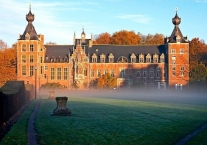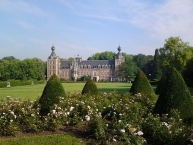Kasteel van Arenberg
Sehenswürdigkeiten
Erstellt am 17.10.2017,
zuletzt geändert von biroto-Redaktion am 17.10.2017
Radwege und Fahrrad-Touren in der Nähe
| Name/Bezeichnung | Typ | km zur Strecke |
|---|---|---|
Route | 0,1 km | |
Route | 0,1 km | |
Route | 0,2 km | |
Route | 0,2 km | |
Route | 0,2 km | |
Route | 0,2 km | |
Route | 0,2 km | |
Tour | 0,1 km | |
Tour | 0,2 km | |
Tour | 0,2 km | |
Tour | 0,2 km | |
Tour | 1,2 km | |
Tour | 1,8 km |
![]()
Bitte warten - Kartendaten werden geladen
Art der Sehenswürdigkeit
Burg/Schloss
Name u. Anschrift
Kasteel van Arenberg
∎∎∎∎∎∎∎∎∎∎∎ ∎∎∎∎∎∎∎∎ ∎
BE-3001 Leuven
GEO-Daten
GEO-Koordinaten
50.86∎∎∎∎ 4.68∎∎∎∎
Höhe
19 m
Kommunikation
Informationen zu Urheber-Rechten | |
|---|---|
Rechte-Inhaber | |
Rechte-Ausprägung / Lizenz | by-sa: CREATIVE COMMONS Namensnennung, Weitergabe unter gleichen Bedingungen |
Link zur Rechtebeschreibung | |
Bild übernommen aus | https://commons.wikimedia.org/wiki/File:Castle_Arenberg,_Katholieke_Universiteit_Leuven_adj.jpg |
Bild hochgeladen | durch ThimbleU am 17.10.2017
|
Informationen zu Urheber-Rechten | |
|---|---|
Rechte-Inhaber | |
Rechte-Ausprägung / Lizenz | by: CREATIVE COMMONS Namensnennung |
Link zur Rechtebeschreibung | |
Bild übernommen aus | https://commons.wikimedia.org/wiki/File:Leuven_University_-_panoramio_(1).jpg |
Bild hochgeladen | durch ThimbleU am 17.10.2017
|
Kasteel van Arenberg is a château in Heverlee close to Leuven
in Belgium. It is surrounded by a park.
The site had been the castle of the lords of Heverlee since the 12th century, but this family became impoverished and had to sell the site in 1445 to the Croÿ family from Picardy. Antoon van Croy demolished the medieval castle and started works to build the current château in 1455 on the site, of which he destroyed all but one tower. Willem van Croÿ completed the works on the château in 1515, and founded a monastery on the château grounds for the Benedictine Celestines. The architectural style is in large part traditionally Flemish, with sandstone window frames and brick walls, though it has been structurally altered since 1515 and has elements of Gothic, Renaissance and Neo Gothic architecture. Its large corner towers are typical, once surmounted by a German eagle.
Charles III of Croy was the 4th and last duke, and after his death in 1612 without issue the château passed to the Arenberg family into which his sister had married, and remained in that family until the First World War.
The château and park were seized by the Belgian government on the outbreak of, and then after the war since the Arenberg family was considered to be German or Austrian due to their close Habsburg connection, monarchs of Austria-Hungary. It took until 1921 for the University to acquire them, becoming an expanded natural sciences and engineering campus in the style of that of an American university. After the partitioning of the university along language lines in 1968, the château and grounds remained with the Dutch speaking half as one of the main campuses for the new, independent Katholieke Universiteit Leuven. The château itself is now used by the Engineering Science faculty of the KU Leuven and is the focal point of a green campus for the group Sciences & Technology.
The former Celestine monastery on the château grounds now houses the campus library, and the addresses of many of the science buildings are on the street named Celestijnenlaan (Dutch for "Celestine Street").
Informationen zu Urheber-Rechten | |
|---|---|
Rechte-Ausprägung / Lizenz | by-sa: CREATIVE COMMONS Namensnennung, Weitergabe unter gleichen Bedingungen |
Link zur Rechtebeschreibung | |
Text(e) übernommen von: |
Wikipedia contributors, 'Kasteel van Arenberg', Wikipedia, The Free Encyclopedia, 17 November 2015, 13:44 UTC, <https://en.wikipedia.org/w/index.php?title=Kasteel_van_Arenberg&oldid=691071901> [accessed 17 October 2017] |
übernommen / bearbeitet am | 17.10.2017
|
übernommen / bearbeitet durch |
|
Öffnungszeiten:
The castle is open to students during the academic year, but unfortunately not accessible to visitors.
Radwege und Fahrrad-Touren in der Nähe
| Name/Bezeichnung | Typ | km zur Strecke |
|---|---|---|
Route | 0,1 km | |
Route | 0,1 km | |
Route | 0,2 km | |
Route | 0,2 km | |
Route | 0,2 km | |
Route | 0,2 km | |
Route | 0,2 km | |
Tour | 0,1 km | |
Tour | 0,2 km | |
Tour | 0,2 km | |
Tour | 0,2 km | |
Tour | 1,2 km | |
Tour | 1,8 km |
Erstellt am 17.10.2017,
zuletzt geändert von biroto-Redaktion am 17.10.2017


